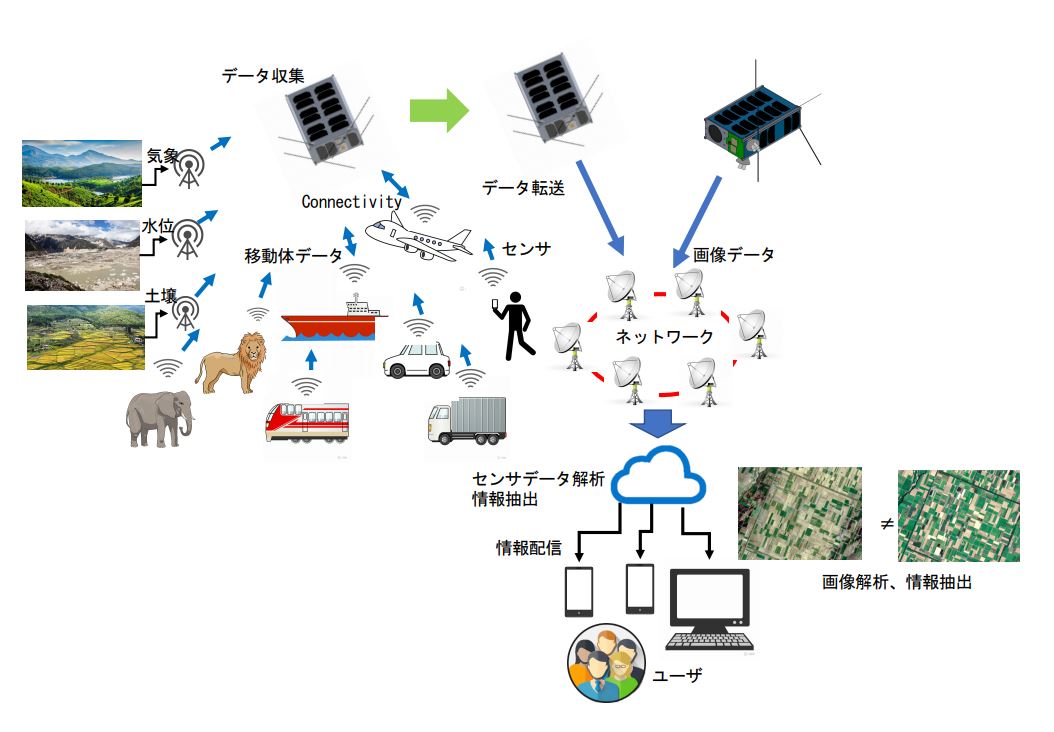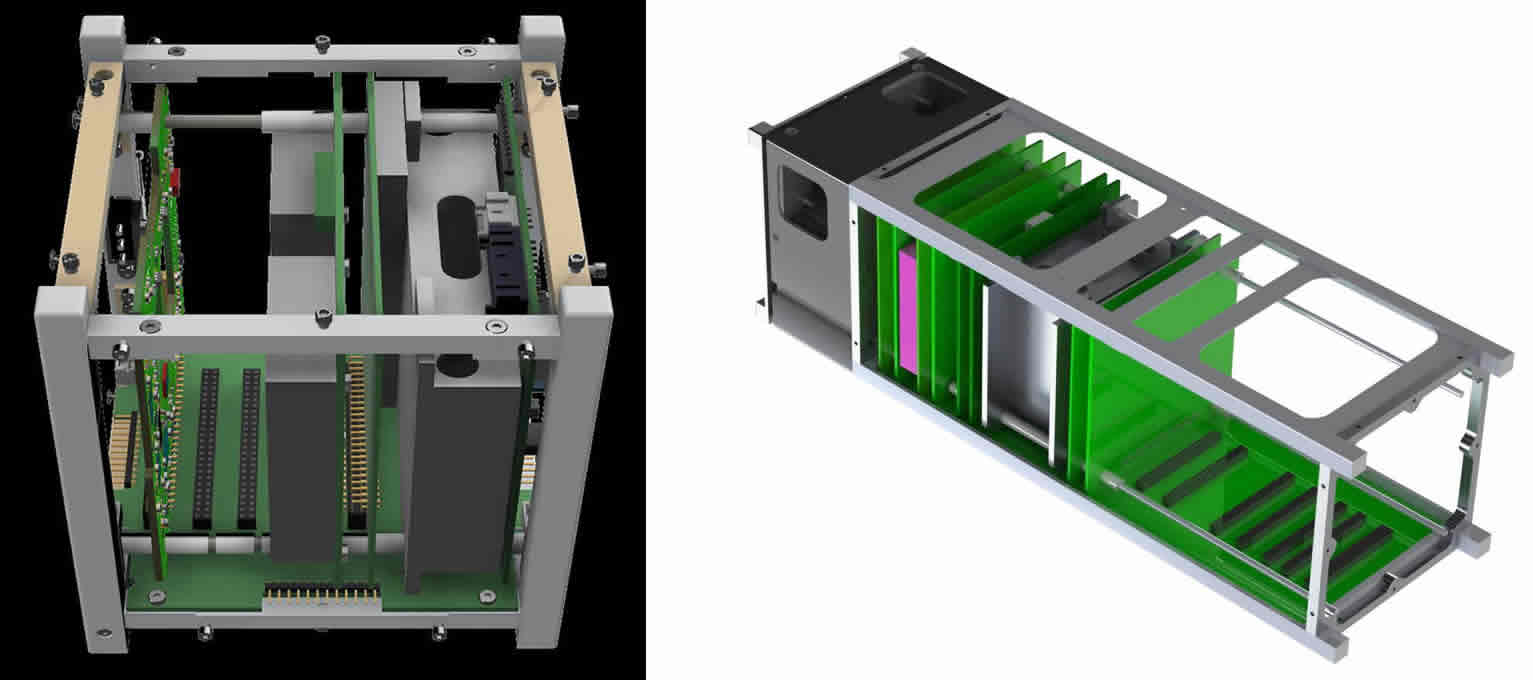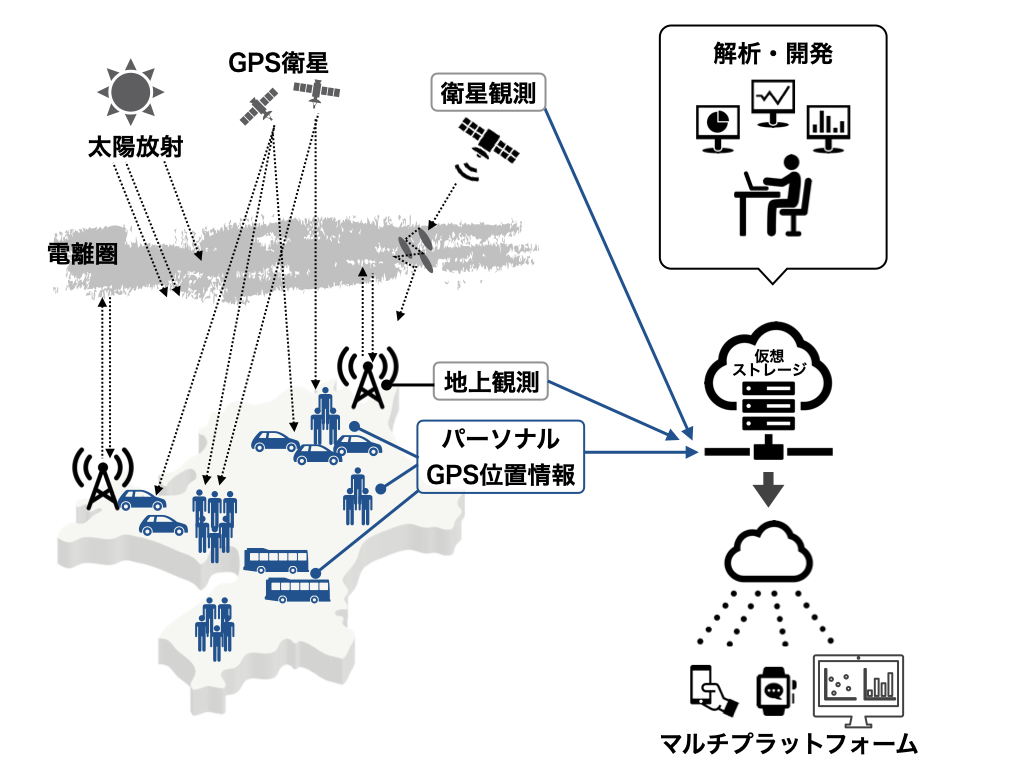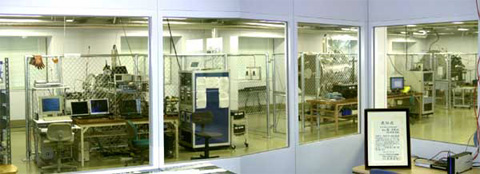Introduction of the new LaSEINE
Our laboratory is conducting a variety of research on space utilization and space technology demonstration. We introduce some of this research below.
Research of small-satellite-derived ground sensor data/satellite image data as well as research about information extraction/distribution based on small satellites
With the "KITSUNE" 6U CubeSat scheduled to be launched in the Year 2021, we will collect ground sensor data and perform high-resolution earth imaging. Based on the acquired data, we will investigate mechanisms for quickly, accurately, and efficiently, providing the information that users need.

This diagram illustrates how ground sensor data and image data are collected and then distributed
Our research related to Lean Satellites
According to Lean Satellite concepts, "In order to provide value created by satellites to customers and users at a low cost and delivered in a short period of time, we take an approach different from the process employed to make conventional large-scale satellites. With the lean approach, there is more emphasis on taking acceptable risks and on reducing waste.” “Lean Satellites” unavoidably become smaller in size and thus in the Japanese language they are virtually synonymous with “small satellites and microsatellites”. In order to advance the concepts of Lean Satellites, we are conducting research on methods to: [1] easily and quickly create satellites, [2] implement the mass production of satellites, [3] design optimal satellite interfaces, [4] manage satellite projects so that waste (time, money, etc.) can be mitigated, and [5] more. Nearly every year, LaSEINE hosts the International Workshop on Lean Satellite.Click here for lean-sat.org
Research on advanced nano satellite missions
Aiming for lunar exploration using CubeSats in the future, we are conducting research on the underlying systems and technologies needed for that. This forward-looking research is being conducted as an international collaboration with three countries: United States (Cal Poly), Singapore (NTU), and Italy (University of Rome, Sapienza).
Research on standardizing the CubeSat bus and on various basic technologies needed for CubeSats
Although most people do not want to make their own satellites, more and more people are seeking simpler means to implement space demonstrations (such as “proof of concept” demonstrations) using 1U or 3U CubeSats. We are developing a 1U or 3U CubeSat standard bus that can be provided to such people as a platform for doing space demonstrations. We aim to allow the space demonstrators to quickly perform “proof of concept” missions by simply building hardware according to pre-agreed interfaces. In addition, we are investigating various new basic technologies that can be exploited for CubeSats -- aiming for advanced, low-cost, quickly-delivered, and yet robust, CubeSats for the general public.

Standard bus for 1U/3U CubeSat
Environmental testing of satellites
The “Center for Nanosatellite Testing” (CeNT), which is a subordinate organization of LaSEINE, performs comprehensive environmental testing of satellites whose dimensions are below 50 cm and whose weight are below 50 kg. We provide this testing service to both domestic and overseas customers. Moreover, Kyushu Institute of Technology takes the global lead for promoting the ISO-19683 Standard (“Space systems — Design qualification and acceptance tests of small spacecraft and units”) with the aim of standardizing environmental tests for nanosatellites. For details, please check the Center for Nanosatellite Testing website.
Knowledge discovery and manufacturing driven by Big Data
We utilize “bio-image informatics” (development of image data analysis methods from the fields of biology and medical science) to improve data analysis for disaster prevention and for the earth sciences (seismology, meteorology, space physics, climate change, etc.).
Data analysis research using the archives of actual data from the field of Sun-Earth science
In the context of an ICT society that makes more and more use of Big Data, we are carrying out research on space-based big data.
Summaries of the ongoing research:
- Development of visualization models of ionospheric disturbance at the time of solar flares that can disrupt human activity. We use ground magnetic data and also ionospheric electric field data.
- Development of aurora video technology to provide new research techniques for examining aurora morphology.
- Basic research on ionospheric characteristics based on big data methodology. This requires the development of a new monitoring system that can reveal more precisely changes in the Earth’s ionosphere.

Space weather research
Humans are already active in space. Between the height of 100 km and 100,000 km above the Earth, we have many satellites operating continuously. In addition, inside the ISS, we have humans working every day. For this high-altitude region right above us, we are examining the following:
- Prediction of geostationary high energy electron flux using neural networks
- Observation of the low-altitude ionosphere using CubeSats
- Application of CubeSat development for basic technology education
Click here for details of research
Research on electrostatic charging and discharging of solar panels
LaSEINE has one of the world's leading ground test equipment to simulate the surface charging of satellites in the space plasma environment and verify the resistance of space equipment to charging and discharging. Since 1999, we have tested the solar arrays installed on domestic satellites going into space; we have conducted charging/discharging tests for other parts as well. We will continue to make effective use of world-class test facilities to test conventional space components for satellites, and develop space-resistant plasma environment technology for the realization of next-generation space systems such as space solar power generation systems and electrodynamic tethers.
In addition, we have been organizing international test standards through the ISO (International Standard Organization) for solar cell charging/discharging tests. Thus far, we have helped to create two ISO standards:① ISO 11221:2011 (Space systems — Space solar panels — Spacecraft charging induced electrostatic discharge test methods) and ② ISO 19923:2017 (Space environment [natural and artificial] — Plasma environments for generation of worst case electrical potential differences for spacecraft)

Charging and discharging test equipment
Research for propulsion systems of nano-satellites
We are developing propulsion systems that can be used in CubeSats. By developing an electric propulsion device utilizing some kind of solid propellant, we seek the ability to: [1] adjust the attitude of satellite, [2] make orbit changes for the satellite, and [3] de-orbit satellite at the end-of-life.
Research on the deterioration of material when used in space
We are evaluating the physical properties of various materials used in space. We look at space environment resistance (hardening), and we are looking into various advanced materials for possible space application. The equipment we currently have: [1] ultraviolet irradiation equipment, [2] thermo-optical properties evaluator, [3] outgas tester, and [4] more. We are one of the leading research centers in Japan for space material research.

UV irradiation equipment